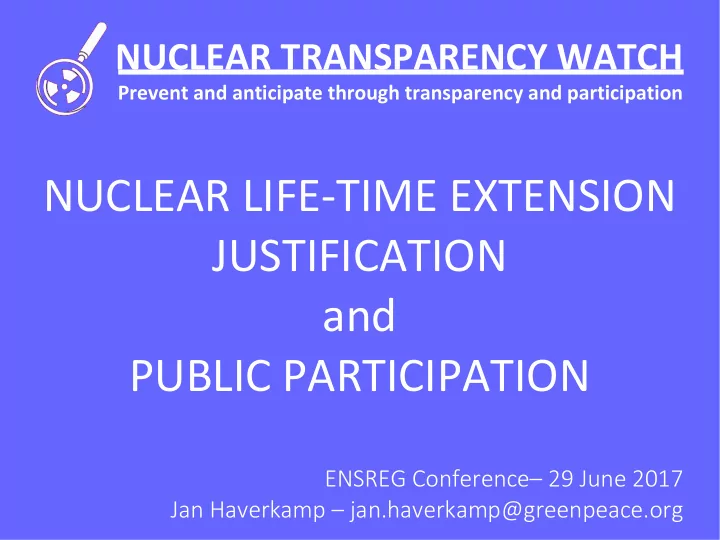

NUCLEAR TRANSPARENCY WATCH Prevent and anticipate through transparency and participation NUCLEAR LIFE-TIME EXTENSION JUSTIFICATION and PUBLIC PARTICIPATION ENSREG Conference– 29 June 2017 Jan Haverkamp – jan.haverkamp@greenpeace.org
NUCLEAR LIFE-TIME EXTENSIONS the situation • 86 nuclear reactors to reach end of initial foreseen technical lifetime in ENSREG countries in the next 10 years • Average age nuclear reactors in ENSREG countries: 32 years • Currently decisions in process: BE, CH, CZ, ES, FI, FR, HU, NL, SE, SI, UK 2/10
NUCLEAR LIFE-TIME EXTENSIONS the justification • Justification : lack of decommissioning funds • UA EIA justification for Zaporyzhzhe and SouthUkraine: “Accumulation of the necessary funds for the decommissioning of power units without a significant increase of consumer load” • But also major role in NL, ES and BE • Concern: Economic arguments interfere with risk management 3/10
POSITION of Nuclear Transparency Watch Natural legal, moral and logical right of citizens confronted with decisions of these impacts to be consulted. The logical instruments for that are the Espoo and Aarhus Conventions and (transboundary) environmental impact assessment . 4/10
ENVIRONMENTAL IMPACTS 1/3 of life-time extension of nuclear reactors 10 or 20 years extra means 25%, 33% or 50% longer operation & impacts: ● Increased use of uranium ; ● Increased production of radioactive wastes ● for >90% of radioactive content no permanent solution exists; ● accumulation of spent fuel or vitrified waste in interim storages; ● Increase exposure to the risk of a severe nuclear accident with substantial emissions of radioactive material an increased risk of a Fukushima type accident ; ● The risk itself grows : ● Risk of accident increases exponentially with ageing (bathtub curve); ● Uprates increase radioactive inventory; ● Upgrades only give a temporary decrease of risk growth; ● Loss of knowledge and skills. 5/10
ENVIRONMENTAL IMPACTS 2/3 of life-time extension of nuclear reactors Construction (for some reactors), and physical changes over the lifetime never submitted to an environmental impact assessment : – Ongoing ageing (bathtub curve!), upgrades, uprates, MOX introduction (all including the impacts of a prolonged lifetime!), related license renewals and license changes; – These are de-facto tiered (layered) decisions leading to a, from the perspective of the public, de facto life-time extension. 6/10
ENVIRONMENTAL IMPACTS 3/3 of life-time extension of nuclear reactors The environment has changed: – physical (amount of inhabitants, nature areas, agricultural activity) – economic (value of surrounding economic activity, form of economic activity – for instance the chemical processes near Doel) – political (need for energy policy actions because of climate change, development of energy structure and grid structure because of variable renewable uptake) – Risk-perception (no acceptance of more Fukushima-type accidents, higher risk reduction standards, standards should match standards for new reactors) 7/10
THE DECISION leading to nuclear lifetime extension After the initial technical foreseen lifetime, there is always a form of decision that leads to life-time extension: ● an operation license prolongation; ● an exploitation license prolongation; ● approval of changes to either the operation or exploitation license; ● By the operator, followed by an administrative or political confirmation; ● A decision related to the Periodic Safety Review; ● tiered (layered) decisions (a mix of political, administrative and/or by the operator); ● In any other form. 8/10
POSITION of Nuclear Transparency Watch Natural legal, moral and logical right of citizens confronted with decisions of these impacts to be consulted. The logical instruments for that are the Espoo and Aarhus Conventions and (transboundary) environmental impact assessment . 9/10
NUCLEAR TRANSPARENCY WATCH Prevent and anticipate through transparency and participation Jan Haverkamp – jan.haverkamp@greenpeace.org
Recommend
More recommend